Bahá'í World Centre buildings
| Bahá’i Holy Places in Haifa and Western Galilee | |
|---|---|
| Name as inscribed on the World Heritage List | |
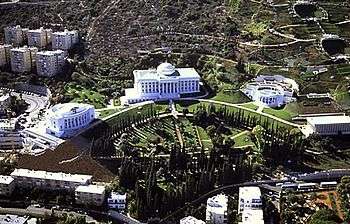 | |
| Type | Cultural |
| Criteria | iii, vi |
| Reference | 1220 |
| UNESCO region | Europe and North America |
| Inscription history | |
| Inscription | 2008 (32nd Session) |
The Bahá'í World Centre buildings are buildings that are part of the Bahá'í World Centre in Israel. The Bahá'í World Centre buildings include both the Bahá'í holy places used for pilgrimage and the international administrative bodies of the Bahá'í Faith; they comprise more than 20 different administrative offices, pilgrim buildings, libraries, archives, historical residences, and shrines. These structures are all set amidst more than 30 different gardens or individual terraces.
The buildings themselves are located in Haifa, Acre, and Bahjí, Israel. The location of the Bahá'í World Centre buildings has its roots in Bahá'u'lláh's imprisonment in Acre, which is near Haifa, by the Ottoman Empire during the period of Ottoman rule over Palestine, now Israel.
Many Bahá'í holy places in Haifa and around Acre, including the terraces and the Shrine of the Báb on the north slope on Mount Carmel, and the Shrine of Bahá'u'lláh, the Mansion of Bahji, and the Mansion at Mazra'ih were inscribed on the World Heritage List in July 2008.[1][2] The Bahá'í shrines "are the first sites connected with a relatively new religious tradition to be recognized by the World Heritage List."[3] The UNESCO World Heritage Committee considers the sites to be "of outstanding universal value [and]...inscribed for the testimony they provide to the Bahá’i’s strong tradition of pilgrimage and for their profound meaning for the faith." [4]
Haifa
Haifa is the third-largest city in Israel, and it is a seaport, located below and on Mount Carmel, and lies on the Mediterranean coast. In 1891 Bahá'u'lláh himself designated Mount Carmel as the location for the Shrine of the Báb. Later, Bahá'u'lláh in the Tablet of Carmel wrote that Mount Carmel would be the physical location of the Bahá'í World Centre.
The Shrine of the Báb

The Shrine of the Báb is the location where the Báb's remains have been laid to rest. The location was designated by Bahá'u'lláh himself in 1891 while he was camped, with `Abdu'l-Bahá, on Mount Carmel. The location is right above the German Colony, which was established in the 1860s by the German Templer Society, who were working for the Kingdom of God on earth. The initial shrine was built by `Abdu'l-Bahá and completed in 1909. Many years later, the superstructure was completed by Shoghi Effendi, and finally dedicated in 1953.[5]
The architect was William Sutherland Maxwell, a Canadian Bahá'í who was a Beaux-Arts architect and the father-in-law of Shoghi Effendi. Shoghi Effendi provided overall guidance, including in the use of Western and Eastern styles, but left the artistic details to Maxwell. Maxwell's design of the Rose Baveno granite colonnade, Oriental-style Chiampo stone arches, and golden dome is meant to harmonize Eastern and Western proportions and style. Some remaining aspects of the dome's structural engineering were designed by Professor H. Neumann of Haifa's Technion University.[5]
After Maxwell died in 1952, Leroy Ioas, an American Bahá'í who had been closely associated with the construction of the Bahá'í House of Worship in Wilmette, Illinois helped Shoghi Effendi in the construction process. Ioas employed his administrative skills and practical mind to supervise the building of the drum and dome, a task done without the availability of sophisticated machinery.[5]
Temporary Shrine of `Abdu'l-Bahá
The Shrine of `Abdu'l-Bahá is the location where `Abdu'l-Bahá's remains have been temporarily laid to rest. It is found in one of the rooms of the Shrine of the Báb; the Shrine of `Abdu'l-Bahá will be relocated to a new structure to be built in the future.
The Arc buildings
The Arc composes a number of administrative buildings as revealed by Bahá'u'lláh in the Tablet of Carmel, built in the shape of an ark which include, the Seat of the Universal House of Justice, the Seat of the International Teaching Centre, the International Bahá'í Archives and the Centre for the Study of the Sacred Texts. The fifth building, the International Bahá'í Library has yet to be built.
Seat of the Universal House of Justice
The Seat of the Universal House of Justice is the building located in Haifa, Israel where the Universal House of Justice, the international governing council of the Baha'i community, sits. It is a large building where the House of Justice consults on the affairs of the worldwide community, meet dignitaries and pilgrims, and attends to other business. It also houses a few other offices of the Bahá'í World Centre.
The building is located at the apex of The Arc and has sixty Corinthian columns around it to mirror the design of the International Archives. The architect was Hossein Amanat and it was completed in 1982 during the second stage of building on the Arc, to be occupied in 1983.
During a Bahá'í pilgrimage the Universal House of Justice addresses the pilgrims and then the members greet each pilgrim in turn.
International Teaching Centre Building
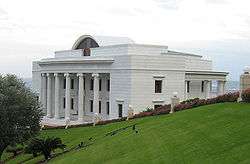
Built in the third stage of the building of the Arc, the International Teaching Centre Building is where the International Teaching Centre is based. This institution coordinates the growth and protection of the Bahá'í community. The architect was Hossein Amanat and it was completed in 2001.
Centre for the Study of the Sacred Texts

Built in the third stage of the building of the Arc, the Centre for the Study of the Sacred Texts is the base of the scholars and translators who study and translate the Bahá'í texts to assist the Universal House of Justice. The architect was Hossein Amanat and it was completed in 1999.
International Archives
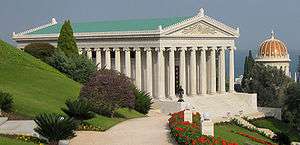
The International Archives is the first building to be built on the Arc and holds many of the most sacred items within the Bahá'í Faith,[6] but most importantly is built for the viewing of the paintings and drawings of Bahá'u'lláh and the Báb, along with a single photograph of Bahá'u'lláh. Although some of these items are available on the internet today, most Bahá'ís prefer to see these items only in a reverent atmosphere, during the pilgrimage.
Shoghi Effendi chose the Parthenon as the basis for the design, possibly due to the apparent enduring beauty even after thousands of years.[7] The capitals of the fifty columns were Ionic rather than the Doric Order.[7] It was finished in 1957 however Shoghi Effendi never lived to furnish the interior. This was left to his wife Rúhíyyih Khanum.
Previously the rear three rooms of the Shrine of the Báb and then the building beside the Monument Gardens now called the Department of Holy Places were temporary Archives buildings.
International Bahá'í Library
The International Bahá'í Library Building specified by Shoghi Effendi is not yet built.[8] The Bahá'í World Centre Library holds an extensive collection of Bahá'í literature. The Universal House of Justice stated: "In future decades its functions must grow, it will serve as an active centre for knowledge in all fields, and it will become the kernel of great institutions of scientific investigation and discovery."[9]
Monument Gardens
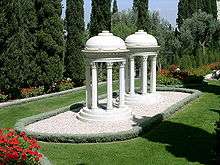
The Monument Gardens within the Bahá'í World Centre are a set of gardens which hold the graves of some of the members of the Bahá'í holy family:
- Mirzá Mihdí — Bahá'u'lláh's youngest son from his first wife
- Ásiyih Khánum — Bahá'u'lláh's first wife
- Bahíyyih Khánum — Bahá'u'lláh's daughter
- Munirih Khánum — `Abdu'l-Bahá's wife
The Terraces
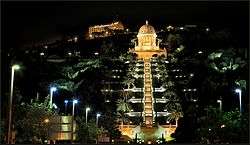
The Terraces are garden terraces that form nine above and nine below the Shrine of the Báb on Mount Carmel within Haifa, Israel.
Nine concentric circles thus provide the main geometry of the eighteen terraces. Just as the identification of a circle presupposes a centre, so the terraces have been conceived as generated from the Shrine of the Báb. The eighteen terraces plus the one terrace of the Shrine of the Báb make nineteen terraces total. Nineteen is a significant number within both the Bahá'í and Bábí religions.
The Visitors Centre
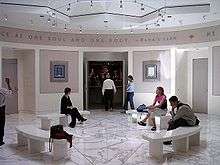
The Visitors Centre is an underground structure on the 11th terrace behind the Shrine of the Báb on Mount Carmel within Haifa, Israel. It can be found on street level under the Hatzionut Bridge which the terraces pass over.
The House of `Abdu'l-Bahá
`Abdu'l-Bahá, who was the head of the Bahá'í Faith from 1892 to 1921, designed and built a house in Haifa on 7 Haparsim (Persian) Street after his father Bahá'u'lláh died. It was completed in 1908, and `Abdu'l-Bahá moved to the house in August 1910. It became his official residence. After his travels to the West, it became the place for the reception of pilgrims to the Bahá'í World Centre.
Pilgrim Houses
Pilgrim Houses signify buildings where pilgrims are (or were) greeted and housed during pilgrimage to the Bahá'í holy places. There have been numerous buildings within Haifa, Israel dedicated to this throughout the last century.
Original Western Pilgrim House
The original Western Pilgrim House, located at 4 Haparsim (Persian) Street in Haifa, Israel, was used as a Pilgrim House for members of the Bahá'í Faith of Western origin, who had come for pilgrimage during the early years of the 20th century, before it was replaced by the new Western Pilgrim House on 10 Haparsim Street.
The house is currently part of the Bahá'í World Centre. While it was originally rented to serve as a Pilgrim House, the house was then bought by `Abdu'l-Bahá. After being replaced by new Western Pilgrim House, the site was then used by members of the Bahá'í holy family. It left Bahá'í hands shortly before being re-bought by the Universal House of Justice.
Second Western Pilgrim House
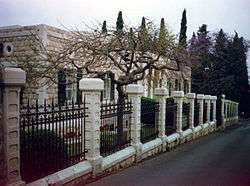
The second Western Pilgrim House, often referred to as "the old western Pilgrim House", located at 10 Haparsim (Persian) Street in Haifa, Israel, was used as a Pilgrim House for members of the Bahá'í Faith who had come for pilgrimage during the first half of the 20th century. It is currently part of the Bahá'í World Centre and used by the Bahá'í International Community Secretariat and related offices.
The house was originally paid for by William Harry Randall, a wealthy American Bahá'í, who felt the facilities of the previous Western Pilgrim House at 4 Haparsim were inadequate. Its construction was started under the instruction of `Abdu'l-Bahá, but was only completed during the time that Shoghi Effendi was the head of the Bahá'í Faith. Although it served originally as the Pilgrim House for western Bahá'ís, it has been used for other purposes more recently:
- From 1951 to 1963 it housed the International Bahá'í Council
- From 1963 to 1983 it served as the Seat of the Universal House of Justice
- From 1983 to 2000 it was occupied by the International Teaching Centre
Eastern Pilgrim House

The Eastern Pilgrim House or the "Haifa Pilgrim House" is a Pilgrim House for Bahá'ís when they go on pilgrimage. The house was built after `Abdu'l-Bahá interred the remains of the Báb on Mount Carmel. The construction of this stone building was supervised by Mírzá Ja’far Rahmání of 'Ishqábád, who also paid all the expenses. It is known as the "Eastern Pilgrim House", as for decades it housed the Persian pilgrims. After 1951, when the Western Pilgrim House at 10 Haparsim Street became the seat of the International Bahá'í Council, it became the Pilgrim House for all pilgrims.
Haifa Pilgrim Reception Centre

The Pilgrim Reception Centre or the "Haifa Pilgrim Reception Centre" is the newest Pilgrim Reception Centre for pilgrimage to sites near the Bahá'í World Centre. It comprises two conjoined buildings, of a historic medical clinic, that have recently been remodeled and opened in October 2000. The building can serve up to 500 people on pilgrimage.[10]
Resting place of Amatu'l-Bahá Rúhíyyih Khanum

The Resting place of Amatu'l-Bahá Rúhíyyih Khanum is situated within Haifa, Israel as part of the Bahá'í World Centre. Originally bought to make sure that the area around the House of `Abdu'l-Bahá was not built up, and used as a garden, it was selected as the burial ground for Amatu'l-Bahá Rúhíyyih Khanum after she died in 2000.
75 HaTzionut Avenue
75 HaTzionut Avenue is a building within Haifa which is part of the Bahá'í World Centre that is not particularly celebrated but has been an integral part of the centre for many years. Amongst other things it has been used for:
- A building where Shoghi Effendi oversaw the development of the Bahá'í gardens.
- An architects office for the building of the Arc.
- As the International Archives building before the permanent building was finished in 1957.
It is currently used as the Bahá'í "Department of Holy Places".
Other

Another structure in the Haifa region is the site of the future Mashriqu'l-Adhkár.
Akká area
Bahá'u'lláh, and his family, was exiled to the prison city of Akká (Modern day Acre) by the Ottoman Sultan Abd-ul-Aziz. Bahá'u'lláh arrived in Akká on August 31, 1868, and lived the rest of his life in the Akká area as a prisoner. His prison conditions were eased in June 1877 and while still a prisoner, he moved to Mazra'ih at that time. The Bahá'í buildings and property in Akká were rented or bought during this period of time.
House of `Abbúd
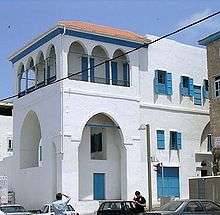
The House of `Abbúd refers actually to two houses:
- The westerly house owned originally by `Abbúd himself. It was the first property to be rented after Bahá'u'lláh's release from confinement into house arrest.
- The easterly house which was owned by `Údí Khammár originally until he let it to the Bahá'í holy family after a few years. `Údí Khammár also owned the Mansion of Bahjí which the Bahá’ís later acquired.
The house provided a home for Bahá'u'lláh's first wife Navváb and her family. It was in this building that the Kitáb-i-Aqdas was written.
House of `Abdu'lláh Páshá

The House of `Abdu'lláh Páshá is one of the properties the Bahá'í holy family used in the Akká area. It was acquired by `Abdu'l-Bahá to fit the growing family and also provide space to welcome pilgrims who had started to arrive.
The name derives from the Akká governor Ibrahim Pasha who owned the house in the early decades of the 19th century.
The first western pilgrims were welcomed here on December 10, 1898.
The Garden of Ridván
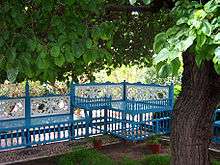
The Garden of Ridván (lit. garden of paradise) is a Bahá'í holy place situated just outside Acre within modern Israel. Originally known as the 'garden of Na‘mayn', it was rented by `Abdu'l-Bahá for Bahá'u'lláh where he enjoyed spending the later part of his life, after years in a desolate prison cell. Although it shares the same name it does not have the same significance of the Garden of Ridván, Baghdad and no connection to the festival of Ridván.
During the 1930s and 1940s the island setting of the garden disappeared, as a result of a draining project against malaria. In 2010 a three-year restoration and conservation project of the garden and the original water canals surrounding it was completed, after which the Ridvan Garden, referred to by Bahá'u'lláh as 'Our Verdant Isle', became an island once again.[11]
Prison cell of Bahá'u'lláh
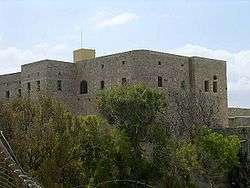
The prison cell in which Bahá'u'lláh lived between 1868 and 1870 has now become a Bahá'í pilgrimage location. Its restoration was completed in June 2004.[12]
Bahjí
Bahjí is a place near Akká where Bahá'u'lláh spent his final years of life. While he was still formally a prisoner of the Ottoman Empire, his prison conditions were eased, and from 1879 he used the Mansion of Bahjí as his home.
Although the Mansion of Bahjí is relatively isolated, with only a small pilgrim house and the Shrine within several hundred metres, there used to be a complex of several buildings mostly used by the extended Holy family. During the time of Shoghi Effendi, these buildings (and the land around them which are now used as gardens) were bought up or traded for land near the Sea of Galilee. Several of the buildings were demolished as they had been used by covenant breakers. Tiles from the roofs were used to pave the garden pathways, and the material recovered from the razed buildings was used to construct a large windbreak to the northeast of the Mansion.
Shrine of Bahá'u'lláh
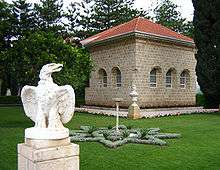
Located in Bahjí, the Shrine of Bahá'u'lláh is the most holy place for Bahá'ís — their Qiblih. It contains the remains of Bahá'u'lláh and is near the spot where he died in the Mansion of Bahjí.
The Mansion of Bahjí
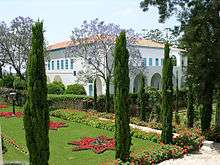
The Mansion of Bahjí is the house where Bahá'u'lláh died in 1892. It was built in 1870 over an earlier, smaller building by `Udi Khammar, a wealthy merchant from Akká who was also the original owner of the House of `Abbúd. It remained in his family's hands until 1879, when an epidemic caused the inhabitants to flee. The mansion was subsequently rented to the Bahá'í holy family for a very small amount of money. `Udi Khammar's tomb is still within the main Mansion compound, on the southeast corner of the wall. The Mansion is now a Bahá'í pilgrimage site.
Bahjí Visitor Centre
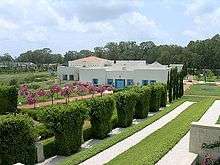
Located in Bahjí and near the Shrine of Bahá'u'lláh, the Bahjí Visitor Centre contains basic facilities used by visitors and Bahá'í pilgrims.
Mazra'ih
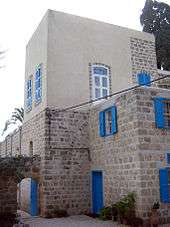
Located four miles (6 km) north of Akká in Mazra'a, Bahá'u'lláh used this country house during the summers from June 1877 until 1879, before moving to a larger house within Bahjí. It left Bahá'í hands for several decades and was slightly restructured with an annex added to the front. This meant that a staircase, previously on the outside is now within the house's walls. It originally belonged to `Abdu'lláh Páshá, and is located four miles (6 km) north of Acre.
Mazra'ih was transferred from a Muslim waqf to the Bahá'ís subsequent to the establishment of the state of Israel.[13][14]
"Masra'ih is a Moslem religious endowment, and it is consequently impossible, under existing laws in this country, for it to be sold. However, as the friends are aware, the Ministry of Religions, due to the direct intervention of the Minister himself, Rabbi Maimon, consented, in the face of considerable opposition, to deliver Masra'ih to the Baha'is as a Holy Place to be visited by Baha'i pilgrims. This means that we rent it from the Department of Moslem and Druze affairs in the Ministry of Religions. The head of this Department is also a Rabbi, Dr. Hirschberg. Recently he, his wife and party, visited all the Baha'i properties in Haifa and 'Akka, following upon a very pleasant tea party in the Western Pilgrim House with the members of the International Baha'i Council."[13] (Baha'i News, no. 244, June 1951, p. 4)
The mansion was ultimately purchased by the Bahá'ís in 1973.[14]
Notes
- ↑ UNESCO World Heritage Centre (2008-07-08). "Three new sites inscribed on UNESCO's World Heritage List". Archived from the original on 10 July 2008. Retrieved 2008-07-08.
- ↑ World Heritage Committee (2007-07-02). "Convention concerning the protection of the world cultural and natural heritage" (PDF). p. 34. Retrieved 2008-07-08.
- ↑ Israeli Baha'i sites recognized by UNESCO Haaretz.com
- ↑ UNESCO World Heritage Centre (2008-07-08). "Bahá'i Holy Places in Haifa and the Western Galilee". Archived from the original on 16 July 2008. Retrieved 2008-07-08.
- 1 2 3 "Golden anniversary of the Queen of Carmel". Bahá'í World News Service. 2003-10-12. Archived from the original on 26 May 2007. Retrieved 2007-05-12.
- ↑ The Life of Bahá'u'lláh: Holy Relics
- 1 2 Rabbani, R. (1969). The Priceless Pearl (Hardcover ed.). London, UK: Bahá'í Publishing Trust: 2000. p. 264. ISBN 1-870989-91-0.
- ↑ Memorandum from the Research Department of the Universal House of Justice Questions about Aspects of the Baha'i Teachings (Item 23: International Bahá'í Library Building)
- ↑ The Universal House of Justice: Letter to the Followers of Baha'u'llah throughout the world, 31 August 1987
- ↑ "Reception Center opens for Baha'i pilgrims to the Holy Land". Bahá'í World News Service. 2000-09-18. Retrieved 2009-10-6.
- ↑ BWNS: Holy place restoration sheds light on region's heritage 29 October 2010.
- ↑ "Holy place restored and open to pilgrims". Bahá'í World News Service. 2004-11-24. Retrieved 2009-10-6.
- 1 2 Holley, Horace (June 1951). "International Baha'i Council Haifa, Israel" (PDF). Bahá'í News (244). Retrieved May 10, 2016.
- 1 2 Universal House of Justice (1976). "Ridván Message 1973". Messages from the Universal House of Justice 1968-1973. Wilmette, IL: Baha'i Publishing Trust. p. 113. ISBN 0-87743-076-4.
References
- `Abdu'l-Bahá (1971). Memorials of the Faithful (Softcover ed.). Wilmette, Illinois, USA: Bahá'í Publishing Trust: 1997. ISBN 0-87743-242-2.
- Taherzadeh, A. (1976). The Revelation of Bahá'u'lláh, Volume 1: Baghdad 1853-63. Oxford, UK: George Ronald. ISBN 0-85398-270-8.
- Taherzadeh, A. (1984). The Revelation of Bahá'u'lláh, Volume 3: `Akka, The Early Years 1868-77. Oxford, UK: George Ronald. ISBN 0-85398-144-2.
- Taherzadeh, A. (1987). The Revelation of Bahá'u'lláh, Volume 4: Mazra'ih & Bahji 1877-92. Oxford, UK: George Ronald. ISBN 0-85398-270-8.
- Smith, Peter (1999). A Concise Encyclopedia of the Bahá'í Faith. Oxford, UK: Oneworld Publications. ISBN 1-85168-184-1.
Further reading
- Momen, Moojan (2009). Bahá’í World Center. Bahá’í Encyclopedia Project.
External links
| Wikimedia Commons has media related to Bahá'í Arc. |
- "The Bahá'í Gardens - Official Website". Bahá’í World Centre. 2009-03-31.
- "Bahá'í pilgrimage". Bahá’í World Centre. 2009-03-31.
- Coordinates of Baha'i Holy Sites (2016)
- "Holy place restored and open to pilgrims, about the prison cell of Bahá'u'lláh". Bahá'í World News Service. 2009-03-31.
- "Photos of the Bahá'í World Centre buildings in Haifa". BahaiPictures.com. 2009-03-31.
- "Haifa's Majestic Bahai Gardens - A UNESCO World Heritage Site". Israel News. 2009-03-31.
Coordinates: 32°48′44″N 34°59′11″E / 32.81222°N 34.98639°E